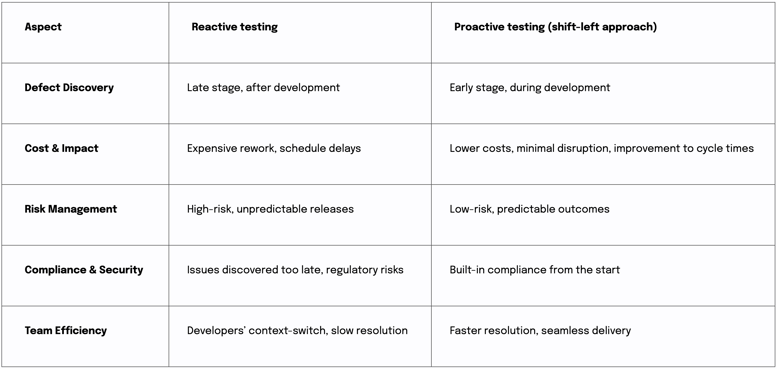Financial services leaders don’t just need transformation; they need transformation they can trust. One compliance failure, one security flaw, or one failed system launch can derail an entire strategy. Yet, too many firms still rely on outdated, reactive testing approaches that introduce uncertainty. The result? Costly overruns, unexpected delays and sometimes even compliance breaches that could have been avoided.

The answer isn’t more testing - it’s smarter testing. Instead of catching defects late in the process, what if you could detect defects earlier?
What is shift-left testing and why does it matter?
Shift-left testing refers to the practice of embedding testing earlier in the software development lifecycle. While it’s not a new concept in the testing world, it remains as relevant today as ever – especially as organisations strive for faster releases, higher quality and reduced risk. This allows teams to identify defects when they're easier, cheaper and less disruptive to fix. Rather than treating testing as a final checkpoint, it becomes an integral part of every development stage.
In the legacy approach, testing happens predominantly after development is complete. This reactive model inevitably leads to late-stage discovery of issues, costly rework and unscheduled disruptions - exactly what financial services leaders are trying to avoid.
The shift-left advantage is clear: by enabling fast feedback loops and catching issues early, it minimises defects, reduces costs and delivers the predictable outcomes that financial services demand.
Reactive vs. proactive testing: a direct comparison
To understand the business impact of shift-left testing, let's compare the traditional reactive approach with proactive testing:

The contrast couldn't be clearer. Reactive testing introduces the uncertainty and risk that financial services leaders seek to eliminate, while proactive testing provides the control and predictability they need.
Compliance, security and customer experience benefits
For financial services firms, the benefits of shift-left testing extend well beyond efficiency and predictability:
-
Regulatory compliance: Early-stage compliance and security testing reduces regulatory risks and ensures systems are audit ready from day one. This proactive approach is invaluable in an industry where non-compliance can result in hefty fines and reputational damage.
-
Operational resilience: By building disaster recovery and failover testing into the development process, financial institutions can ensure their systems meet operational resilience requirements, which are a growing focus for regulators worldwide.
-
Customer trust: Higher-quality software leads to better customer experiences and fewer disruptions. In an era where digital experience often defines the customer relationship, this can translate directly to improved satisfaction and retention.
Consider this real-world example: A financial services organisation discovered major security vulnerabilities just two weeks before a major platform launch, resulting in a three-month delay and significant additional costs. With a shift-left approach, these issues would have been identified during early security testing, avoiding both the delay and the last-minute scramble to fix critical vulnerabilities.
Overcoming challenges: culture, capability and buy-in
While the benefits are compelling, implementing shift-left testing in financial services isn't without challenges:
-
Technical skills gap: Shift-left approaches often require automation expertise and coding knowledge that traditional testing teams may lack. Investment in training and upskilling is essential.
-
Cultural resistance: Developers and product teams may initially see earlier testing involvement as a blocker rather than an enabler. Building understanding of the business case and demonstrating early wins is crucial.
-
Process change: Moving from a traditional waterfall or siloed approach to integrated, agile testing requires process adjustments that touch multiple teams. Clear leadership and governance help smooth this transition.
How to shift from reactive to proactive testing and defect prevention
Transitioning to a shift-left approach requires deliberate action but the benefits far outweigh the effort. Here are the key steps to embedding testing from day one:
Involve Quality Engineering from day one:
-
Ensure testing leaders have a seat at the table during initial planning and sprint meetings.
-
Build collaborative relationships between Quality Engineering teams and product owners.
-
Make testing requirements part of the acceptance criteria for features. Ensure teams adopt preventative processes and a collaborative way of working within Quality Engineering - prevention of defects is better than early detection!
Embed testability into design:
-
Develop platforms and applications with test automation in mind.
-
Include Security, Performance, and Resilience testing considerations in initial designs.
-
Create testable modules that can be validated independently.
Automate where possible:
-
Implement continuous testing within CI/CD pipelines.
-
Develop automated regression test suites that run with each code change.
-
Free up testing teams to focus on high-value, complex test scenarios.
Enable a quality-first culture:
-
Make quality everyone's responsibility, not just dedicated testers.
-
Shift mindsets from defect detection to defect prevention.
-
Celebrate quality metrics alongside delivery milestones.
Testing is often perceived as a cost, but its true value lies in defect prevention rather than defect detection. Preventing defects at the source eliminates waste, reduces risk and protects your bottom line. When defects slip through, they don’t just cause inefficiencies - they put your business at risk by undermining customer confidence and draining time, money and resources.
The future of predictable transformation
In financial services transformation, predictability is key. Shift-left testing provides the control, certainty and efficiency that leaders need to implement complex technology change confidently.
Financial institutions can innovate with significantly less risk and greater predictability by catching issues early, building in compliance from the start and driving a preventative rather than reactive approach to quality.
The most successful financial firms already know that transformation without control is just risk in disguise. Shift-left testing helps you stay in control, meet deadlines and deliver predictable outcomes.
Want to ensure your next transformation runs smoothly?
Contact us to learn how our approach keeps complex projects on track.
